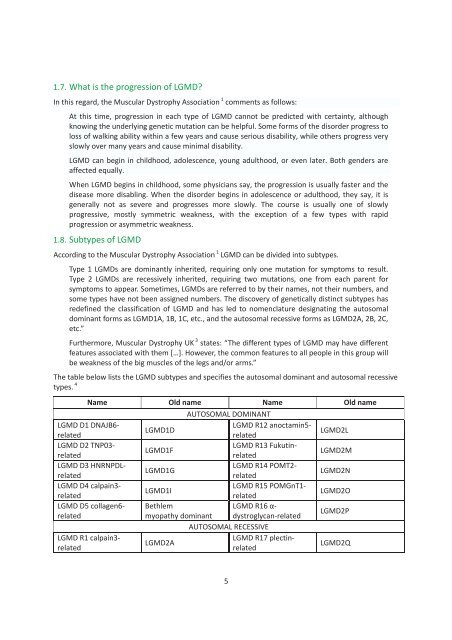You also want an ePaper? Increase the reach of your titles
YUMPU automatically turns print PDFs into web optimized ePapers that Google loves.
1.7. What is the progression of <strong>LGMD</strong>?<br />
In this regard, the Muscular Dystrophy Association 1 comments as follows:<br />
At this time, progression in each type of <strong>LGMD</strong> cannot be predicted with certainty, although<br />
knowing the underlying genetic mutation can be helpful. Some forms of the disorder progress to<br />
loss of walking ability within a few years and cause serious disability, while others progress very<br />
slowly over many years and cause minimal disability.<br />
<strong>LGMD</strong> can begin in childhood, adolescence, young adulthood, or even later. Both genders are<br />
affected equally.<br />
When <strong>LGMD</strong> begins in childhood, some physicians say, the progression is usually faster and the<br />
disease more disabling. When the disorder begins in adolescence or adulthood, they say, it is<br />
generally not as severe and progresses more slowly. The course is usually one of slowly<br />
progressive, mostly symmetric weakness, with the exception of a few types with rapid<br />
progression or asymmetric weakness.<br />
1.8. Subtypes of <strong>LGMD</strong><br />
According to the Muscular Dystrophy Association 1 <strong>LGMD</strong> can be divided into subtypes.<br />
Type 1 <strong>LGMD</strong>s are dominantly inherited, requiring only one mutation for symptoms to result.<br />
Type 2 <strong>LGMD</strong>s are recessively inherited, requiring two mutations, one from each parent for<br />
symptoms to appear. Sometimes, <strong>LGMD</strong>s are referred to by their names, not their numbers, and<br />
some types have not been assigned numbers. The discovery of genetically distinct subtypes has<br />
redefined the classification of <strong>LGMD</strong> and has led to nomenclature designating the autosomal<br />
dominant forms as <strong>LGMD</strong>1A, 1B, 1C, etc., and the autosomal recessive forms as <strong>LGMD</strong>2A, 2B, 2C,<br />
etc.”<br />
Furthermore, Muscular Dystrophy UK 3 states: “The different types of <strong>LGMD</strong> may have different<br />
features associated with them *…+. However, the common features to all people in this group will<br />
be weakness of the big muscles of the legs and/or arms.”<br />
The table below lists the <strong>LGMD</strong> subtypes and specifies the autosomal dominant and autosomal recessive<br />
types. 4 Name Old name Name Old name<br />
<strong>LGMD</strong> D1 DNAJB6-<br />
related<br />
<strong>LGMD</strong> D2 TNP03-<br />
related<br />
<strong>LGMD</strong> D3 HNRNPDLrelated<br />
<strong>LGMD</strong> D4 calpain3-<br />
related<br />
<strong>LGMD</strong> D5 collagen6-<br />
related<br />
<strong>LGMD</strong> R1 calpain3-<br />
related<br />
AUTOSOMAL DOMINANT<br />
<strong>LGMD</strong>1D<br />
<strong>LGMD</strong> R12 anoctamin5-<br />
related<br />
<strong>LGMD</strong>1F<br />
<strong>LGMD</strong> R13 Fukutinrelated<br />
<strong>LGMD</strong>1G<br />
<strong>LGMD</strong> R14 POMT2-<br />
related<br />
<strong>LGMD</strong>1I<br />
<strong>LGMD</strong> R15 POMGnT1-<br />
related<br />
Bethlem<br />
<strong>LGMD</strong> R16 α-<br />
myopathy dominant dystroglycan-related<br />
AUTOSOMAL RECESSIVE<br />
<strong>LGMD</strong>2A<br />
<strong>LGMD</strong> R17 plectinrelated<br />
<strong>LGMD</strong>2L<br />
<strong>LGMD</strong>2M<br />
<strong>LGMD</strong>2N<br />
<strong>LGMD</strong>2O<br />
<strong>LGMD</strong>2P<br />
<strong>LGMD</strong>2Q<br />
5

















